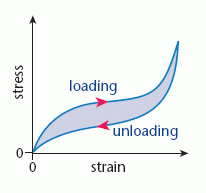Rubber
Graphs that show the variation of stress with strain have the same shape as the force-extension graphs on page 31. The gradient of these graphs represents the stiffness of the material, i.e. how difficult the material is to stretch. The structure of natural rubber is like a can of worms, consisting of long chain molecules with occasional cross-linking between the chains. This is shown in the diagram below.
The difference between a force–extension graph and a stress–strain graph for the same material is that they have different values and units on the axes.

When rubber is stretched the stiffness gradually decreases and it becomes relatively easy to stretch as the chains uncoil; once this has happened the rubber is much stiffer.
The stress–strain graph for rubber (below) shows that the behaviour as a load is removed is not the same as that when the load is being increased. This is called hysteresis and the curves are said to make a hysteresis loop. In unit 1.3. Under stress, it was shown that the energy absorbed or released by a material is represented by the area between the curve and the extension axis of a force–extension graph.

If you repeatedly stretch and release a rubber band, you can feel the effect of heating caused by hysteresis.
The equivalent area on a stress–strain graph represents energy per unit volume.
On a graph of stress against strain:
the area between the curve and the strain axis represents the energy per
unit volume.
This is the energy absorbed when a material is being stretched and the energy that is released when the force is removed. Rubber absorbs more energy during loading than it releases in unloading. The difference is represented by the area of the hysteresis loop, shown shaded in the stress–strain graph.
The effect of hysteresis in rubber is to transfer energy to its molecules, resulting in heating. A car tyre goes through hysteresis for each revolution of the wheel. If the tyre is under-inflated this can lead to a ‘blow-out’ when the air inside the tyre becomes hot and the tyre explodes due to the increase in pressure. Modern, energy-efficient tyres reduce the problem of hysteresis by using a rigid rubber for the tyre walls and a more flexible rubber for the tread.
Most tyres use the same rubber to do two different jobs; provide rigidity for the tyre wall and elasticity for the tread.

